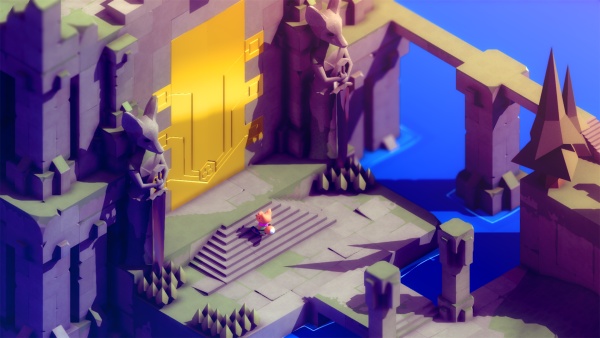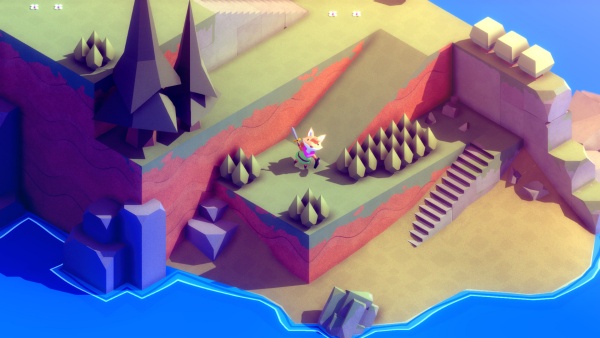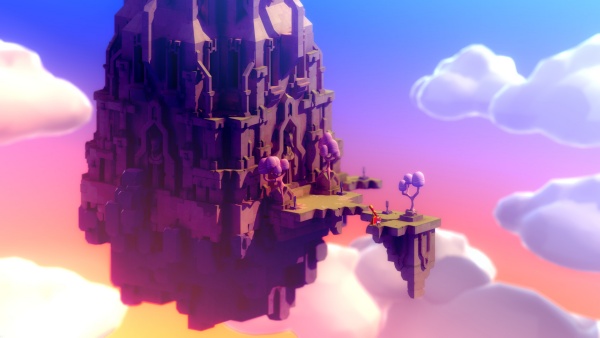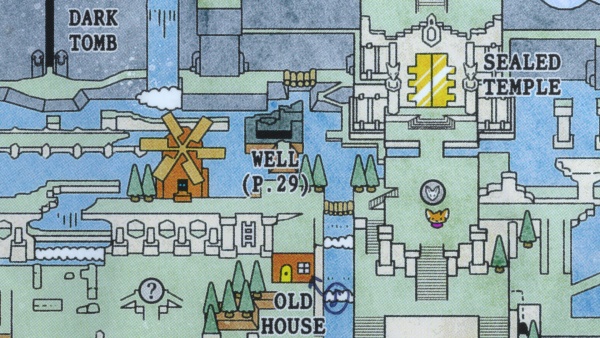It’s been quite a year, hasn’t it? There have been some incredible games so far for 2022 with one major highlight being Elden Ring of course. The immense adventure game with very little handholding and intensely challenging yet rewarding venture through an epic fantasy land. And what do we have here? An immense adventure game with very little handholding and an intensely challenging yet rewarding venture through an epic fantasy land. But Tunic is under the guise of wonderfully cute aesthetics yet could beat Elden Ring at its own game in a few areas.
What is Tunic? 
Tunic is an adorable, yet challenging isometric adventure game which takes influences from Dark Souls and Zelda, but adds some neat concepts regarding its world, exploration, and problem-solving. You play a sweet little fox who finds themselves on an island, with only the faintest of goals, to become “The Heir”. There is little else to go on, aside from gathering three stones and ringing two bells, our little fox moves onward to complete their destiny.
You’ll be venturing across the Other World and all its various areas, including dangerous forests, creepy graveyards, beautiful temple ruins, underground caves, and many other weird and spectacular places which add an amazing sense of wonder and compelling lore. Our Fox hero will have to do plenty of scavenging to find new weapons and useful items. But also, be able to understand even the simplest of gameplay mechanics.
While you have many of the stables for the genre, including simple yet enjoyable combat, puzzles, big boss battles, and finding glorious treasure, there are interesting dynamics to make Tunic a little more special.
Through exploration, players will piece together the inner workings of the world via a game manual. The pages are scattered across the world and finding them will reveal complex actions and even the simplest mechanics such as how to fast travel. An interesting approach to learning the ins and outs of the world, as you must play through the game, keep exploring and find the manual pages to grasp core gameplay mechanics. Quite interesting on the first run, but on repeat playthroughs, it changes the dynamics of progression in some unique ways, as knowledge becomes powerful in the second and third playthrough.
Players will also see that the game world has many curves and altitudes that interlock pathways in some impressive ways. But one of the most thoughtful concepts Tunic has to offer is with its secrets and how “hidden in plain sight” most of these are.
Looking at the world from another angle 
The one thing which every fantasy epic needs is an epic fantasy world, and Tunic has one impressive one for several reasons. The visual presentation is phenomenally awesome, with an elegant, cubist look to the general layout, but with plenty of neat touches of detail and an art style evoking so many emotional tones. You can be venturing through a dense and dim forest, or an open and bright landscape much akin to a Zelda map or traverse a damp and decedent swap land before heading into a beautifully complex and gothic Cathedral. Plus, there are some more “Alien” terrains which really throw a colourful and weird spanner in the works, for all the right reasons.
The artists behind the scenes have also managed to create such iconic imagery that has been infused in my memory and will stay with me for years to come. Even some smaller moments filled me with so many emotions, whether it was wonder or dread. A moment beautifully set up was when I powered on an elevator that rose from the depths of a dark pit, it brought forth reaching the top where I stood a mound of skulls, which littered the area around me. I was so terrified of what was coming next and Tunic does so many moments like this, setting up and paying off encounters so brilliantly.
Even with a graphical stance that is simple in nature, Tunic can bring about a vast number of interesting locations with rather beautiful art. But what makes Tunic’s world vastly more compelling to explore and enriching to make discoveries is a simple and clever trick.
There are plenty of isometric games on the market and is a viewpoint that offers plenty of advantages to players. It looks better than a simple top-down view and adds a layer of the atmosphere, giving much of the world geometry to make it feel more alive. But these games do just that with this type of camera, use it for visual presentation only. Tunic takes one step further and uses the camera and the design of the world to hide many paths and secrets in plain sight. At an angle, you can clearly see many of the intended paths, but tilting the camera or following your instinct to look around a dark corner of a wall might reveal a new path, an unseen treasure or even something much more.

Tunic hides many of the world’s paths and treasures with fore-ground and mid-ground objects and you will most likely never see them unless you use the camera tilt mechanic (which is used for locking onto enemies) or by simply searching along walls or areas bathed in shadows. The developers really wanted players to explore the world, figure out the logic of its design and reward them by revealing a path that was hidden in plain sight.
While it can be argued that this type of exploration is not new, the way the developers used the camera tricky to keep many of its secrets hidden is incredibly brilliant. It allows players to find plenty of rewards, beneficial to them, such as upgrading attack and defence. But also, to get you to thoroughly explore each region of the world, take risks and try and find the routes which are the beaten path. Conceptually, its a very clever design choice and gives you plenty of “Ah-ha!” moments, which are always nice. Even finding the random shops across the world was a treat!
However, I can understand that some people might find this a little grating at times, and trust me, there were a couple of moments where is it (but for another reason), the game does teach you well and you do get into the rhythm of the world’s design quickly.
A higher lifeform! As mentioned, Tunic has a wonderful art style, but the music is also fantastic. Composer Lifeform managed to create a soundtrack that is oddly other-worldly, yet extremely pleasant to accompany your journey. The music feels right at home, with each track giving an immense level of atmosphere to each area, whether it’s for a lighter or much darker venture.
As the game has many moments which contradict, yet complement each other at every turn, Lifeform has managed to create a series of musical moments that feel very unlike your typical fantasy game, but very fitting at the same time. Plus, the music just sounds super nice, and if someone said to me “Awesome Techno-infused Fantasy soundtrack”, I would say Tunic’s music perfectly matches that description.
Fantastic little Fox! 
You may have gathered the gist of this Fox’s amazing journey in Tunic, where you explore, fight enemies, gather treasure, and must save the day. That’s true, but much of what you actually need to do is shrouded in much mystery.
Your goal is to collect three gems and reunite them in a beautifully ominous temple. Each gem is guarded by a big bad boss and to beat them you’re going to need to get a lot stronger. Doing this reveals a new path, and complex turn in the story. But much of the game is about venturing through the lands and discovering the many mysteries which lie within.
You will explore many regions of the world, looking for paths to inter-connect each region and expand your search further. You will gather exotic items which buff you out or have another special-purpose altogether. There are new weapons out of the way from the path, which you need to find yourself. There are big puzzles that need figuring out and don’t expect any hints or quest markers.
Tunic is simply about discovery and finding your way to the core objective by any means. Even when you find the manual pages, much of the text is in another language, and figuring out how to perform a small action can take some figuring out. You just have to dive in and explore or try out a delicious-looking strawberry and hope it doesn’t kill you, or where to use a number of gold coins you find. Or even just how to Fast Travel. Tunic is brilliantly designed to encourage discovery and learning.
You do have the standard affair of bosses which are challenging and otherwise fun to figure out how to defeat. Along with a large roaster of enemies which provides nice combat encounters in the many areas of the world. There is a limited line-up of weapons sadly and this could have been expanded upon. You have your basic stick, sword, explosives, and some magical weapons, which were all fine to use, but you’ll see soon enough that only a few have a real impact until the very end. Once I found a widespread blasting weapon, I was hooked on using this and defeated several bosses with it. I wished there were more exciting weapons in Tunic as the latter half of the game does not offer many new or exciting tools and gadgets.
You can find a series of cards that can be applied and adds various buffs and attributes to the lovable Fox, but again, you might find yourself just using the best ones. But, the weapons and attributes were generally fine, and the enemy variation, along with the neat environmental elements such as good old explosive barrels helped flesh out combat to be enjoyable overall.
Did you Google it? 
As mentioned, the camera angle and world design cleverly hide many of the routes to glory and the developers have managed to do this trick as many times as possible, but really at the right times (most times). There are traditional puzzles in the game, a few littered throughout the world, but the main lateral elements in Tunic involve the camera and world design. The main use for this visual trickery is the small stuff, but it does find its way into some aspects of discovering or reaching new areas.
So the first area, is full of hidden paths, and they're all useful, quite well hidden but most of the time you will find them and be thrilled when you do. But there are some moments when you need to reach an important section of the map and the environment feels as though you may have to do something greater to solve the problem at hand.
One moment I came across the graveyard and found the gate locked to the next section. Nowhere was there a lever or key for the gate, but in the manual, there was a little skull icon with the number four. I thought “Hey, maybe I need to die here 4 times and I’ll be on the other side?” (yeah, I may have overthought it). But the simplest solution, and arguably the most uninteresting, was the right one. Which was a hidden path of course, on the far side in a very well-covered part of the area. This felt a little disappointing considering it was an important area, and I had hoped there was a trick to progressing forward, much like a Souls-Borne game or even a Zelda one.
But on the flip side, there was a cool little puzzle in this area anyway (that skull icon does come into play soon after), and while only a few bigger puzzles in the game, they have the right amount of complexity and layer to unravel, making them memorable and engaging. The previous point isn’t a massive negative, but the visual trickery is maybe used a little too comfortably more often in important areas than it should.
There will be certainly moments when you may want to Google something and I would say “Just play the game” as everything does come full circle. But I will admit that there were a couple of notes, maybe a little too hidden or easily missed. Meaning you can miss some critical info that will help you progress unless you do some epic backtracking or searching (before learning how to fast travel, backtracking can be a little tedious).
Plus, after major events in the story (including a particularly big one that unlocks an achievement named “What now?”), there’s no guidance at all. You have to figure out where to go on your own. Which is amazing, providing you know where to go or have an idea, or even patience to explore. I can understand as no hand-holding can be worrying and even frustrating to some players, as even games like Dark Souls and Bloodborne, sometimes spell out where you need to go. I personally liked this no-hand-holding approach, but no guidance at all for 99% of the game, will indeed throw some people off guard.
Overall? Tunic is simply amazing in so many ways, and really has a firm grip on being one of the best games this year in my humble opinion. This little fox’s epic adventure is one of the most impressive adventure games I've played in recent memory, with its beautiful aesthetics, awesome world design, and immense exploration, that gives an overwhelming sense of accomplishment in finding the many hidden rewards. Tunic has really been quite a spell-binding experience and my time playing it has made me realise that smaller, independent games can have the same effect as a massive, AAA, big-budget fantasy epic.
While I enjoyed playing a certain other big fantasy game that came out recently, Tunic has personally kept me enthralled with its world and journey, and I absolutely love it!
+++ A phenomenally designed and compelling world
++ Looks and sounds absolutely amazing
++ Challenging, yet highly rewarding
++ Great camera tricky and other neat dynamics
-Some steep learning curves
-Could have done with a couple more interesting puzzles
An Xbox One review copy of Tunic was provided by the publisher for the purpose of this review





